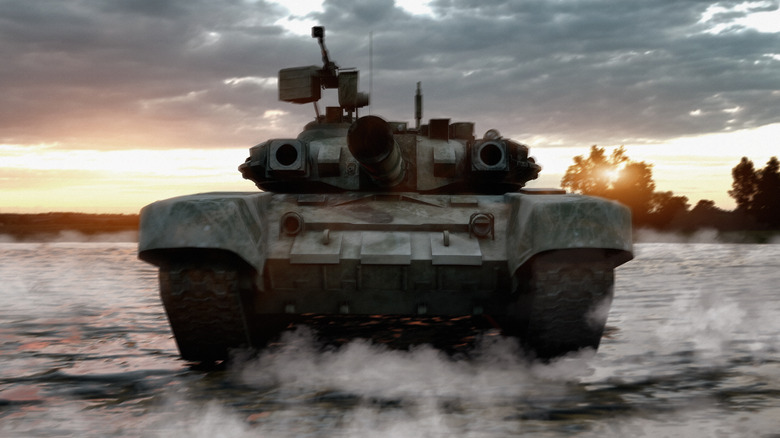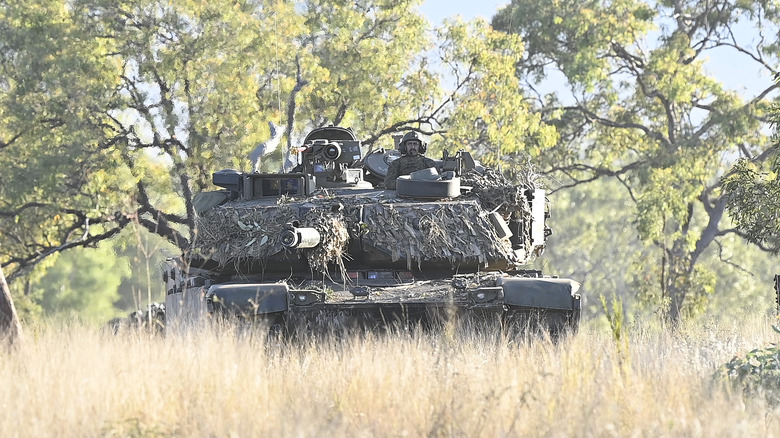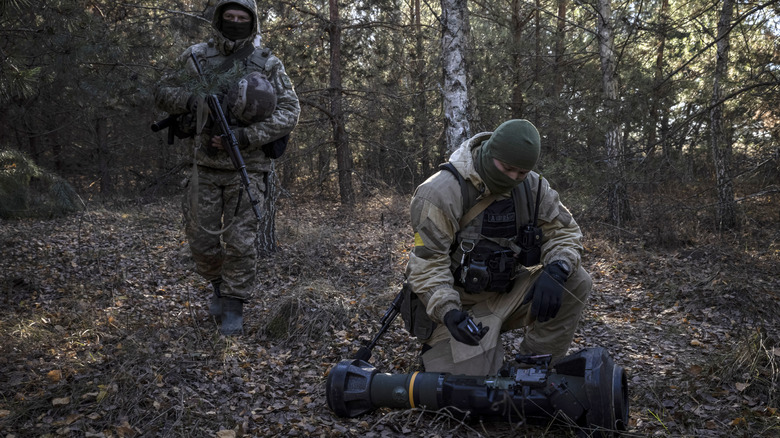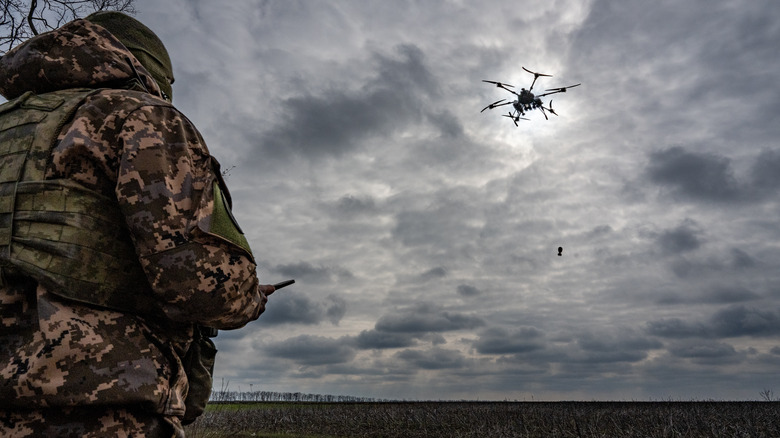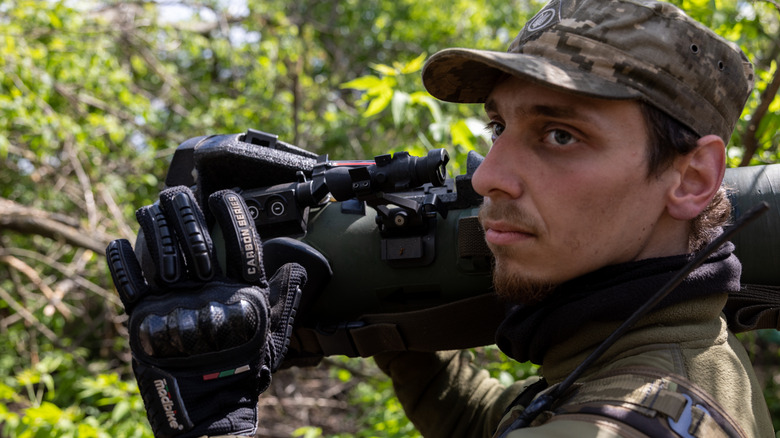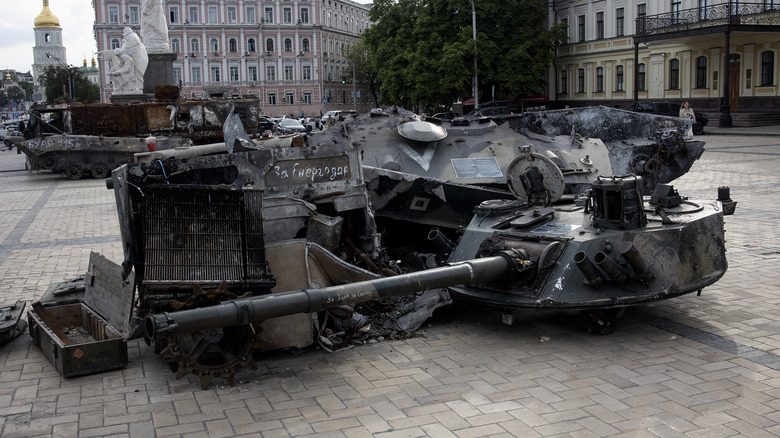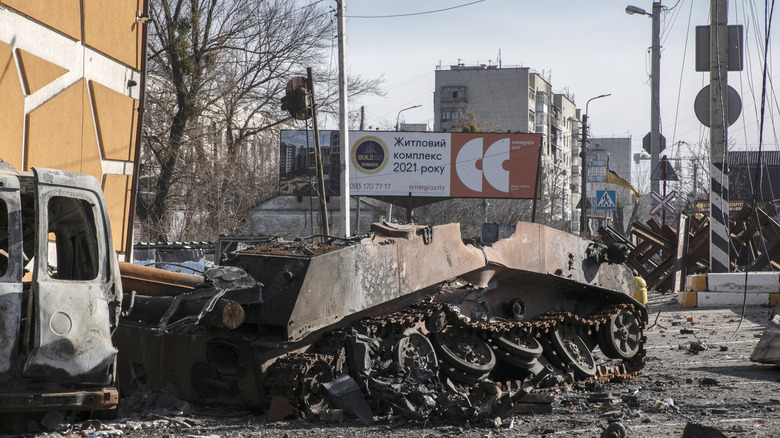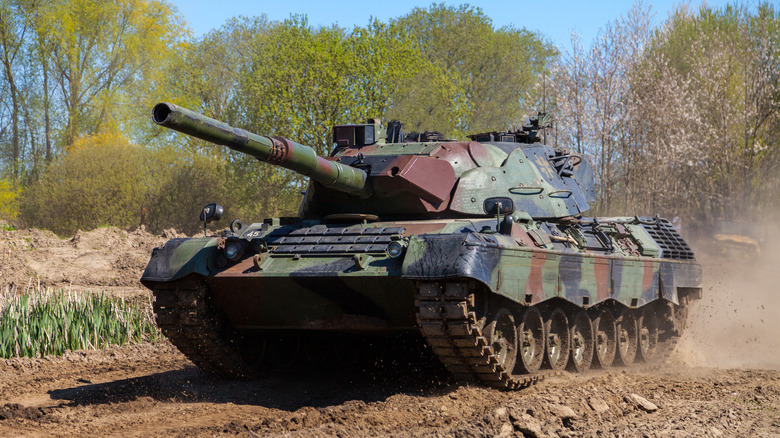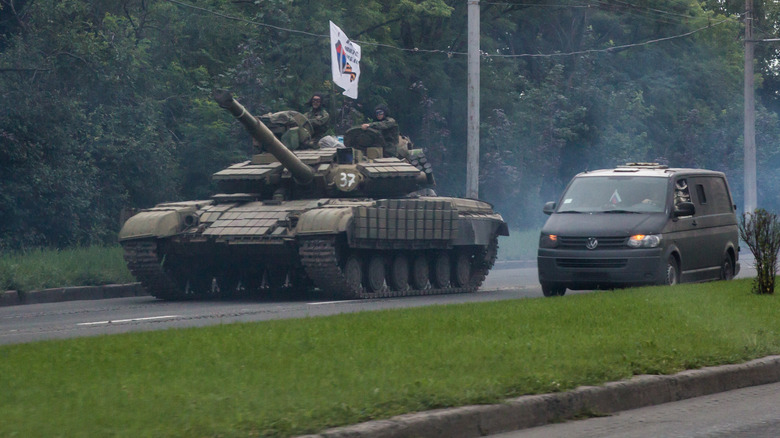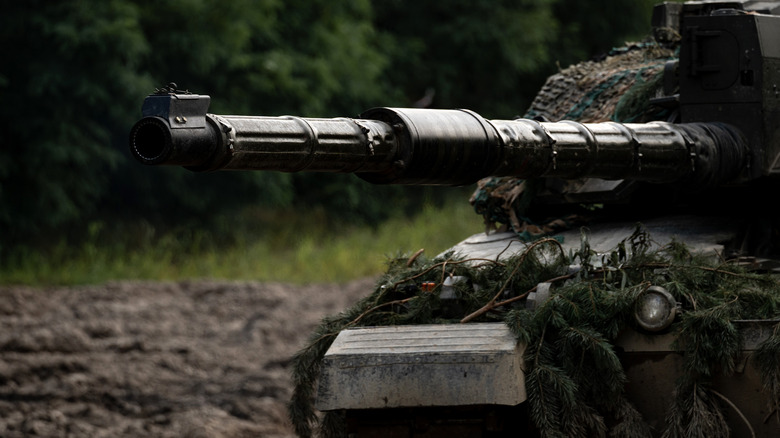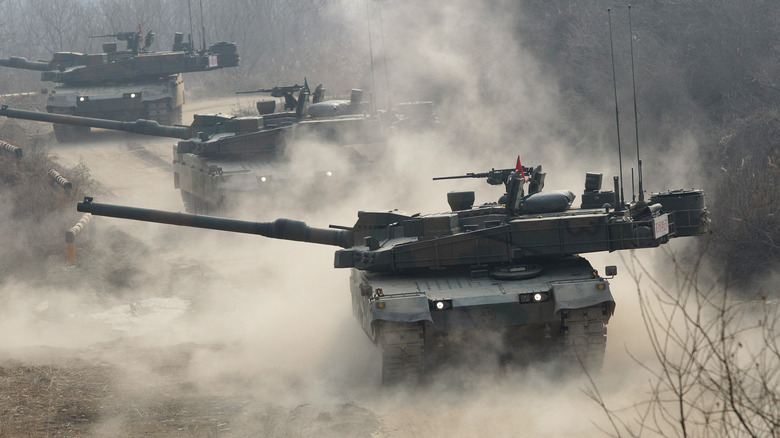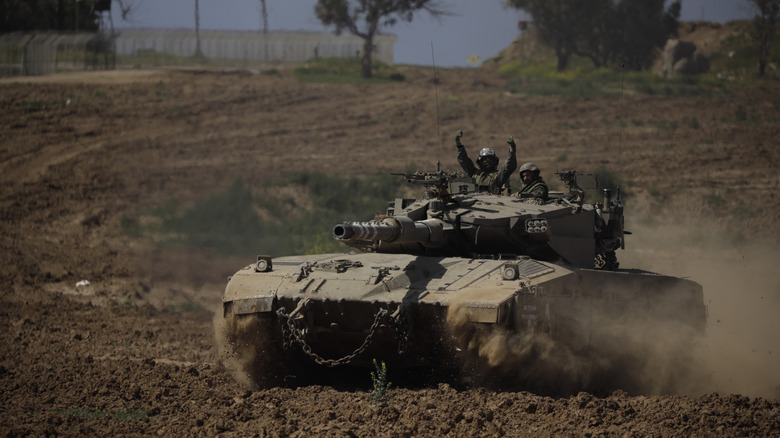Are Tanks Useless In The Modern Age? Here's What Experts Have Said
There is little denying the influence and importance of the tank in modern armies. With more than 70,000 tanks in active service around the world, they make up a huge part of every military force. In numerous conflicts and wars, they've proved effective at pushing through enemy lines and acting as a protector to infantry troops on the ground. Yet, their dominance may well be coming to an end.
Recent wars, including the Russian invasion of Ukraine and the Second Nagorno-Karabakh War between Armenia and Azerbaijan, have cast doubt on the role of tanks. In these conflicts, they've been outgunned and destroyed en masse by infantry weapons and the best military drones. Recent news that certain countries are cutting back their tank fleets and the U.S. Marine Corps is scrapping its three tank battalions has led to speculation that the tank as we know it might not be as useful as it once was.
To determine what the future may hold for the tank, and whether it will continue to play a major role or become obsolete, SlashGear has examined the thoughts of several experts, from defense analysts to strategic planners, historians, and military personnel.
Tanks have been part of warfare over a century
For more than a century, tanks have played an important role in warfare. Since their introduction during World War I, they have formed the backbone of many militaries when it comes to armored vehicles, acting as the vanguard during assaults and a first line of defense against oncoming attackers. Over the years, they have evolved from slow-moving fortresses on tracks to vehicles with specialized and varied roles.
Early tanks usually fell into one of three categories — light, medium, and heavy. However, the Cold War saw states beginning to use modern technology to create what is known today as the main battle tank (MBT). This concept essentially combined the main strengths of the previous types into one complete package. They had the firepower and armor of heavy tanks but the agility and speed of medium and light tanks. That has made them incredibly effective weapons in many theaters of war, where they can head over any terrain and break through the enemy line.
Many of the best and most widely used tanks today are several decades old. While advances in technology have allowed for some upgrades, these have usually been applied to older models, with few completely new designs entering service over the last decade or so. This includes the M1 Abrams, a tank considered to be one of the best of all time, as well as the Leopard 2 battle tank, and the Challenger 2.
Cheap weapons destroyed 10% of Russian tanks
One of the major problems with tanks in the modern age is that they are vulnerable to weapons that are widespread in infantry units. In the past, it was difficult for troops to take the offensive against tanks without heavy weaponry or air and artillery support. That is no longer necessarily the case, and soldiers who are on the ground can fight these armored behemoths and actually deal decisive blows.
Speaking to Business Insider, military strategy consultant Edward Luttwak explained how warfare has changed in that regard. Troops who are operating on foot have the firepower to hurt tanks. "An infantry that is determined to fight is now super-empowered by having things like a huge number of point-and-shoot disposable anti-tank rockets," he said.
What makes disposable weapons — known as next-generation light anti-tank weapons (NLAW) — so useful is their flexibility. As noted by manufacturer SAAB, "NLAW can attack from almost any position, from up high in a building to behind a tree or in a ditch." It is little surprise, then, that so many Russian tanks have been destroyed by Ukrainian infantry in the conflict so far.
Drones are also proving effective
Although NLAW weapons and other point-and-shoot systems have given infantry troops an effective way to fight back against tanks, another far more modern method is proving just as deadly. Cheap drones armed with explosives are proving to be highly effective at taking tanks out of action in Ukraine. In fact, Ukrainian forces have now set up dedicated drone units tasked with flying these small devices against enemy units.
In an interview with Politico, the director of the Dronarium military academy gave an indication of how drones are being used in the war against Russian forces. "It is almost impossible to shoot it down," Pavlo Tsybenko said. "Only a net can help. And I predict that soon we will have to put up such nets above our cities, or at least government buildings, all over Europe."
Drones are also incredibly efficient, as they can be put together and adapted to become weapons of war quickly and easily. Speaking about the ones used by Ukrainian forces, Tsybenko explained: "This drone costs up to $400 and can be made anywhere. We made ours using microchips imported from China and details we bought on AliExpress. We made the carbon frame ourselves. And, yeah, the batteries are from Tesla."
Anyone can use NLAW weapons
The ease of use of NLAWs has made them an ideal weapon against tanks. Almost every soldier can be trained to use them and they don't require much skill — some say it can take as little as one hour to learn how to use them in combat. "The weapon that makes a huge difference is these NLAWs, a light anti-tank weapon, the plastic tube with a hollow charge rocket," military strategy consultant Edward Luttwak told Business Insider. "You point and shoot. A truck can drop 500 of them at the street corner in Kyiv."
Drones are not as easy to use as NLAWs. They require an entire team to work properly, ranging from scouts looking for pilots, engineers to service them and add explosives, and pilots that can fly them at enemy targets. There's also concern about the fact that most drones in use by Ukrainian and Russian forces originated in China, prompting fears the country could gain access to sensitive information.
Yet, Ukraine's military forces have found a way around this potential problem. "When we talked to Europeans, they were amazed at how easy it is to hack and anonymize Chinese drones. It is safe to use them, we tried to persuade our partners," Pavlo Tsybenko said to Politico.
Tanks are no longer a useful vanguard
Tanks were originally designed as a tool for breaking through an opposing force's defensive positions. Their armor could protect against heavy enemy fire and they packed the powerful weaponry needed to destroy barricades or artillery. Once they had punched a hole through the enemy's front line, infantry troops and more mobile units could move through and continue the attack. But these armored vehicles are now more vulnerable than ever before, and it simply doesn't make sense for them to be used in this way in the future.
Paul Scharre is a former U.S. Army Ranger and now director of studies at the Center for a New American Security. He believes that tanks will evolve into a new role in the coming years and will no longer serve as a vanguard.
"I suspect that tanks will not go away completely," Scharre said to Breaking Defense. "but they are likely to go the way of the infantry — as a mopping up force for close-in engagements, rather than the central role tanks have played in ground combat since World War II."
Urban warfare puts tanks at an increased risk
Wars are increasingly being fought in urban environments rather than wide open spaces. This is partly because current conflicts are taking place in locations where there are lots of large cities but also because populations urbanizing faster and faster all over the world. That is coinciding with a trend where tanks are becoming bigger and heavier than they have been for decades. Both of those facts make tanks more vulnerable than they have been, as the unpredictable and confined spaces of city streets combined with a lack of maneuverability puts tanks in the firing line.
Tanks like the ones being used most widely by Russia in Ukraine are well protected from frontal assault. That's because they feature something known as the glacis, a slanted front-facing piece of armor that can deflect missiles and is resistant to explosions. In a city where an attack can come from any direction, armor at the front of the tank is useless. Enemy attacks can come from the side, back, or even from up high, rendering the tank uniquely vulnerable.
Experts from the Royal United Services Institute told the Economist that "it must be doubted whether existing concepts of armored maneuver will remain viable." The head of land warfare for Janes, Jon Hawkes, spoke in the same article to confirm that the capabilities of infantry weapons now outmatch the armor of tanks: "But the tank is more vulnerable now than it has ever been," Hawkes explained. "We're reaching the apex of the armor versus gun race — and armor has lost that race."
Tanks are incredibly expensive
Another reason tanks may well become less popular within military forces is that they are expensive. While they don't yet rival fighter jets or helicopters, they are slowly rising in price. Of the most expensive tanks ever built, the vast majority are either new models or more recent versions of already established tanks, such as the Leopard 2A8 or the M1A2 SEP Abrams. The extra armor, protection systems, and sensors mean that the best tanks can range in cost from $8.5 million all the way up to $30 million — an incredible sum of money to spend on something that can be destroyed so easily.
It isn't just the initial cost that army chiefs have to take into account either. The cost just to maintain a single tank and keep it in operational condition can be thousands of dollars a year. That figure can quickly add up when a country's military might include hundreds or thousands of individual tanks. Those being used in war are even more expensive, with suggestions that the fuel and upkeep costs of a tank on a battlefield could amount to hundreds of dollars for every kilometer they travel.
Poor tactics make vulnerabilities worse
The debate over the usefulness of tanks in the modern era of warfare stems from the performance of armored vehicles in Ukraine. Russia has lost a huge number of its tanks fighting Ukrainian forces, with estimates suggesting that the figure could be as high as 3,000. Phillips P. O'Brien, professor of strategic studies at the University of St Andrews, believes responsibility cannot be solely placed on the vulnerabilities of the tank, but also on the tactics and strategies of Russian military officials.
That view is shared by several other experts, who believe Russia has misused its fleet of tanks. Speaking to the Economist, analysts from the Royal United Services Institute revealed that Russian tanks were particularly at risk from attack from the side and front, and that has been magnified by the fact that the tanks have had little in the way of air support. "Almost every conflict that has involved Soviet-era tanks from the T-64 onwards has shown the vulnerability of these designs to attacks from above and from the sides," they said.
Russia's failure to establish air superiority over Ukraine and its marching of tanks in single-line convoys in the early days of the war led to massive losses. Drones and infantry troops faced little deterrence from fighter jets, attack helicopters, or bombers, and so could attack with almost impunity. Meanwhile, Russia's military seemingly doesn't have the ability to properly counter the smaller drones.
Tanks are still important
Despite all the challenges tanks face, they are still an important part of armies. This is demonstrated by the fact that Ukraine continues to request tanks from its allies in Europe and the United States. "If you look at what the Ukrainians are doing, they're desperately trying to get hold of our Abrams tanks and German Leopard tanks and some of the better quality arms," said Conrad C. Crane, editor-in-chief at USAWC Press, to CNBC. "It's pretty obvious from that, that the tank is still an important part of the battlefield."
Of course, it is not just Ukraine that is still finding a lot of use for tanks. The armored vehicle still has many advantages and does things that other battle systems cannot do. It continues to play a major role in war games and is likely to do so for some time yet. "You need something that's going to have some protection behind it," explained Bryan Clark, director of the Center for Defense Concepts and Technology at the Hudson Institute. "That's going to allow infantry to be able to either use it for cover or use it for indirect fires."
"No other weapon system provides the firepower, mobility, survivability, endurance, and cost-effectiveness of the tank," said Justin Crump, an intelligence consultant for Sibylline, to the Spectator. "Helicopters can hit hard and fast, but are much more expensive and vulnerable, with huge operational overheads. Cheap missiles are plentiful, but the person firing them, an infantryman, is naturally vulnerable to every weapon on the battlefield, particularly artillery."
Tanks need to evolve to avoid obsolescence
Tanks certainly still have some use and will likely continue to play some sort of role in armies around the world for the foreseeable future, as long as they evolve to suit new operational needs. Otherwise, they could very much become obsolete in the coming years, as they become even more vulnerable to modern weapon systems and new methods of attack.
Retired Russian colonel Viktor Murakhovsky, still sees tanks as an essential part of any military but concedes that future versions will need to improve. "High-intensity combat operations between technologically comparable countries is unimaginable without the large-scale use of tanks," he said to the Economist. He goes on to suggest that future tanks could use their own drones to extend their sensory capabilities, allowing the operators to see around corners or over obstacles that would pose the possibility of ambush.
This is something that historian Jeremy Black (via Business Insider) also suggests could make tanks more formidable and protect them from both infantry and drone attacks. In essence, a tank would act as a sort of mothership that can launch dozens of drones. In the same article, Paul Scharre says tanks are unlikely to be used in a vanguard role but would instead "probably [be] part of the second wave after we turned those armored columns into rubble."
Fourth-generation MBTs are in development
Many countries around the world are now developing fourth-generation tanks, an indication that army chiefs recognize the essential role tanks can still play and the need for them to modernize. In many cases, less emphasis is being placed on providing heavier or thicker armor. Instead, these latest tanks are being designed to make use of protection systems that can detect incoming attacks and either destroy or confuse them while they approach the vehicle.
The United Kingdom has an agreement to replace its very special Challenger 2 tanks with upgraded Challenger 3 models. These new tanks will be fully digitized, giving them the ability to instantaneously share data and sensory information with other military forces, including helicopters, fighter jets, and other land-based vehicles. Germany is also working on the Leopard 3, a successor to its popular Leopard 2.
New tanks are likely to feature far more stealth technology. China's fourth-generation tank is said to focus on moving undetected. The U.S. AbramsX prototype utilizes a hybrid engine, which means it can move around in silent mode, producing very little sound, which makes it harder to detect. Other improvements for future tanks include high-resolution and full-color displays, upgraded sighting systems, and the ability to network with other vehicles and command centers. With an array of electronic and digital counter-measures as well as stealthier designs, these fourth-generation tanks should be less vulnerable.
